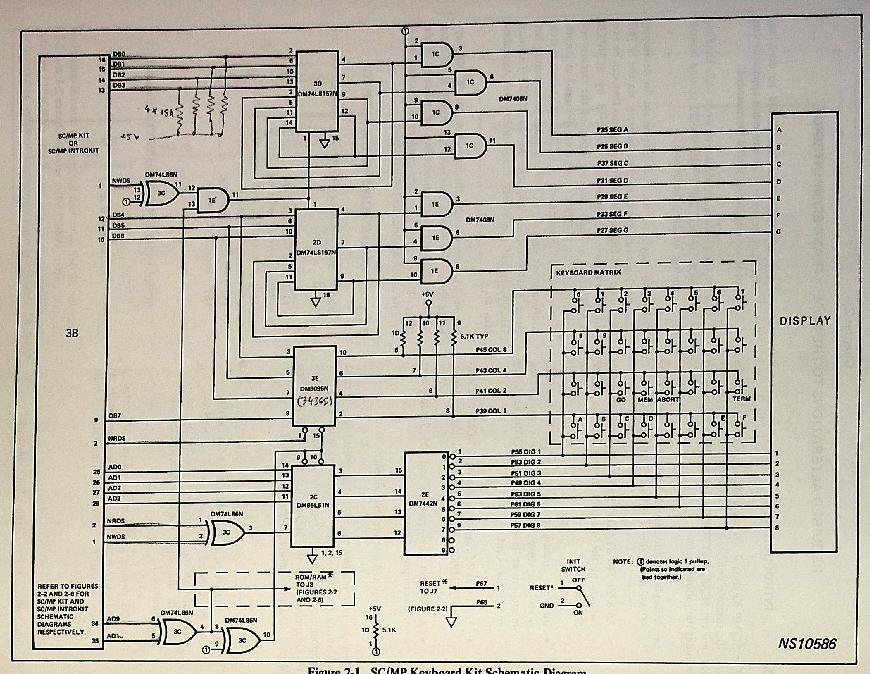

The NANOKIT (Or NANO-KIT) is a National SC/MP II based single board computer with 256 bytes of RAM. You have eight switches to select the memory address and eight switches for the data which you then deposit (DMA!) using a momentary switch. This you do as many times as there are bytes in your program (which you had carefully hand-assembled before, of course).
Then you give the processor control and off it goes.
Unsurprisingly (it's right there in the NAME!), the NANOKIT came as a kit, produced by a company (or maybe just some guys in a garage) calling themselves "Microsystems / Mikrostelsels". Since the manual claims to have been printed in Cape Town, that's probably where they were based. And that explains why you've probably never heard of it.
I bought the NANOKIT secondhand and prebuilt. Well, my parents bought it for me. It came with a set of ROMs piggybacked onto / underneath the RAM chips, containing a program to play "Die Stem" (The old South African Anthem) through one of the output pins.
The manual has all the information you need if you already understand how these things work (and grasp that all references are relative, which is something that evaded me for a while) -- looking back I can see why I had such a hard time wrapping my brain around this stuff. OK, the fact that I was something like twelve at the time might have had something to do with it.
If you have more info, please contact me.
2002-09-23: Received email from Stephen Davies, who says that he also has one, which he got in 1977 or so. Stephen says he knew Andre Wagner who knew the designer.
I took my NANOKIT apart, I needed the switches for another project (yea, I was young). But I have since put it back together. I have also reverse engineered the schematic, although this is still a work in progress: PDF, KiCad.
Somewhere along the way, the 2111 RAM chips went missing (this is strange, I never throw anything away). And of course by now, 2111s are unobtanium. Completely unobtanium. Fortunately, one can substitute a 6116, and I have plenty of those. A 6116 being 2 kilobytes, this gives us eight "pages" of 256 bytes each, so space for eight programs.

Fortunately, the 2111s line up on a 0.1" grid (not a given, in the days of hand-taping PCB layouts). Also, the space between the two 2111 sockets is exactly one 6116. Now to fire up VeeCAD to optimise the design.
~~~ Time Passes ~~~
The NANOKIT has a 5V regulator based on a 317 voltage regulator chip. I fitted a new LM317, and noticed that the 5V supply was low. The BoM gives values of 350R and 1k for R1 and R2, which implies an Iadj of 180uA for 5V output. This might have been the case back then, these days Iadj is 50uA and R1 should be 340R.
The SC/MP came in two flavours, namely P-MOS (INS 8050 ISP-8A/500 SC/MP-1, 1976) and N-MOS (INS 8060 ISP-8A/600 SC/MP-2, 1977).
The P-MOS SC/MP-1 is kind of strange in that it needs the standard +5V but also -7V. Well, it's actually not that strange -- if you call the +5V rail zero, then the voltages are -5V and -12V, the opposite of the +5V and +12V the Intel 8080 needs to run (OK, the 8080 also needs -5V, and to this day your PC power supply probably has a -5V rail even though there's nothing using it).
National Semiconductors offered a "SC/MP Demonstration Kit" (PCB 5514879/B, ISP-8K/200) (Manual dated March 1976) which consisted of a SC/MP processor, 256 bytes of RAM and a 512 byte Mask ROM. The ROM contained KITBUG which allowed the user to interact with the Demonstration Kit using a Teletype.
In October 1976 they added a keyboard and display, consisting of basically a calculator body on a ribbon cable. A replacement ROM with "SCMPKP" firmware and a whole bunch of TTL was required.
The National Semiconductors Introkit (PCB 551305229) is slightly bigger than the Demonstration Kit it closely followed (in time and in design -- actually I suspect the schematics are identical). The instructions for the SC/MP Keyboard Kit cover both PCBs.
The Sinclair MK14 is very similar to these kits, which is pretty much the point of Demonstration Kits.

National SC/MP Keyboard Kit Schematic

Sinclair MK14 Schematic. Compare the right hand half of the schematic with the Keyboard Kit Schematic. GO MEM ABORT TERM all in the same place even.
| 1050 hits since 2015-07-17. | Back to Wouter's Page | (This page last modified 2025-08-02) |